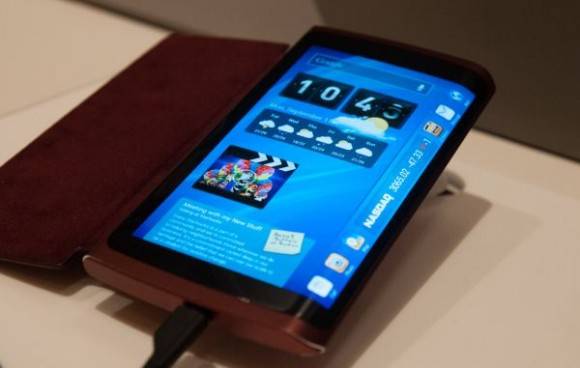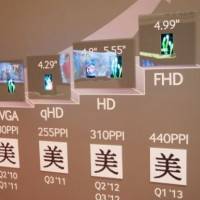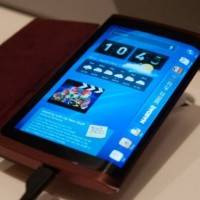
While the star of the show for Samsung at CES was most likely their massive Ultra HD TV sets they had a few tricks up their sleeve in the mobile world, they were just hiding from most of the public. Samsung was showing off their curved or “flexible” AMOLED display technology, something we’re hopeful will make its first consumer appearance on their upcoming Galaxy S IV.
Earlier in 2012 Samsung named their flexible display tech YOUM, and that’s what their curved displays were being called as they hid from the general public at CES. Buried at the company’s stand was a few demo models of their YOUM curved displays on a smartphone, and the folks from AnandTech managed to snap a few photos.
One of the more important aspects of these demos, was the fact that one was 4.99-inches and rocked a 1080p display. Basically what’s been rumored for the Galaxy S IV flagship. With an expected release date as Q1 2013, we’re pretty sure we’ll be seeing it real quick. It isn’t all about larger screens, HD resolution, and curves either. Samsung states these new next-gen AMOLED displays will be over 25% more efficient, and sip on our battery life.
We’ve heard the term “flexible AMOLED” and while this new technology is curved it can’t actually be bent by the end user. Instead we could see a curve to the side or bottom of the display that will work like an always on “ticker” sharing important details. No longer would we need to waste battery by waking that entire 5-inch screen just to see who called or what a notification is for. A small area in a low power state (the curved bit) can share notifications, missed calls, text previews, incoming emails and more. Essentially like the news ticker at the bottom of ESPN. The ideas and possibilities are endless. Hopefully we’ll be learning more about Samsung’s innovative plans in the coming weeks and months. Who likes the idea of a curved edge notification bar on their phone?
[via SlashGear]













Flexible as in bendable?
Yes, though it would likely still be behind a glass exterior. It mainly allows for new design possibilities and protection; such as making the screen (internally) more durable. If you did manage to crack the screen, it work just fine and only need the external glass replaced, not the whole screen.
because now if you dropped the phone you would definately break the screen.
truth…
the blogger forgot to mention that it is “unbreakable.” There are few youtube videos that are showing a person hammering on the screen and it keeps on going.
well said
unbreakable screen, samsung, 1080p display, android… whats more to ask for??
I can hear Apple now, “crap maybe we shouldn’t of sued Samsung, now we will never get our hands on flexible screens”
What ROM is that it doesn’t look like JellyBean?
Wait it is still kind of rectangular, doesn’t Apple have a patent on rectangles now?
Quality Youtube clips of this in action: https://www.youtube.com/watch?v=ciI5RkJLhhA
Flexible, bendable screens.